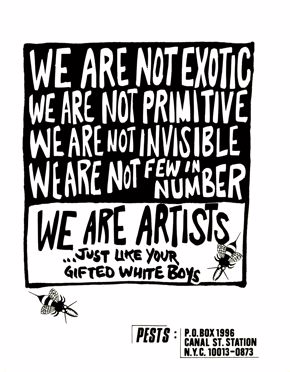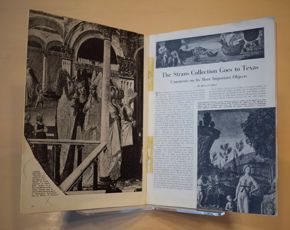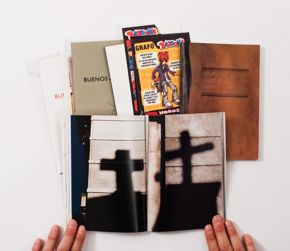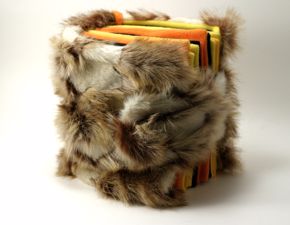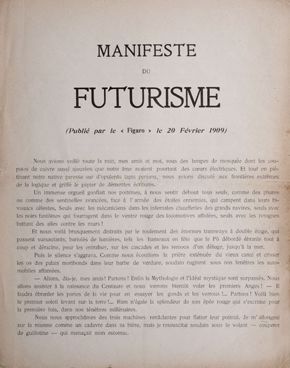Hirsch Library Exhibitions
Visit the Hirsch Library during regular hours to see exhibitions featuring volumes from the library’s collection of rare books.
Bea Nettles: Myth Maker, Storyteller
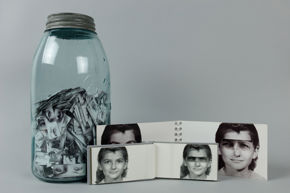
Bea Nettles, Observer Series, Various objects. The Museum of Fine Arts, Houston purchase funded by the Caroline Wiess Law Accessions Endowment Fund, Photography Book Collection.
Bea Nettles, Mountain Dream Tarot: 78 Photographic Cards, Offset printed tarot deck. The Manfred Heiting Book Collection, museum purchase funded by the Caroline Wiess Law Accessions Endowment Fund.
Bea Nettles, Paris Rome & London, Unique artists’ book. The Museum of Fine Arts, Houston purchase funded by the Caroline Wiess Law Accessions Endowment Fund, Photography Book Collection.
March 13–June 15, 2024
For more than 50 years Bea Nettles has mined her memory and vivid imagination to create photographic narratives that are deeply personal, and yet, universal in nature. From the outset her works have taken the form of photobooks that merge image and text, addressing subjects as diverse as mythmaking, autobiography, and relations with the natural world. Works from a feminine perspective ran counter to the largely male-dominated photobook world that began to develop in the 1960s and 1970s. Not one to be deterred by tradition or expectation, Nettles explored the potential for publications that embraced a more intimate and introspective sensibility, forging a trail for others in her wake.
The Hirsch Library recently acquired more than 50 photographically illustrated books directly from the artist, making for one of the most substantial collections of Nettles’s work. Featured here are 14 publications representing the full range of this singular figure in the field of photobook making.
► On-site
Hirsch Library is located on the lower level of the Audrey Jones Beck Building.
► Online
The virtual edition of Bea Nettles: Myth Maker, Storyteller is available 24/7.
The Gorgeous and the Grotesque: The Illustrations of Edward Gorey
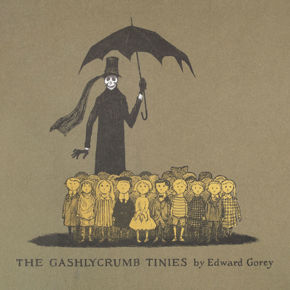
Edward Gorey, The Gashlycrumb Tinies, or, After the Outing, New York: Peter Weed Books, 1962, Hirsch Library, gift of Will Michels.
Edward Gorey, The Unstrung Harp, or, Mr. Earbrass Writes a Novel, New York: Duell, Sloan, and Pearce; Boston: Little, Brown and Company, 1953, Hirsch Library.
H.G. Wells, The War of the Worlds, illustrated by Edward Gorey, New York: Looking Glass Library, 1960, Hirsch Library, the Randy Tibbits and Richard Bebermeyer Book Jacket Collection.
November 1, 2023–March 9, 2024
Related Event
March 7 / Meet the Books: “The Gorgeous and the Grotesque: The Illustrations of Edward Gorey”
The work of Edward Gorey has been seen in books across various genres, illustrated on posters for ballets, constructed on stage for Broadway productions, and featured on public television for more than seven decades. The many different styles of Gorey’s book illustrations, for which he is best known, represent his morbid, yet fascinating way of looking at the world. His drawings feature a plethora of subjects: odd figures in ominous landscapes, quirky people in humorous situations, gothic houses filled with skeletons and ghosts, alien machines burning people alive, naughty children torturing animals, and character after character meeting an untimely end.
Yet Gorey (1925–2000) draws in such a way that, no matter how odd or grotesque, every scene is filled with intrigue and wonder. From his early days illustrating the work of other authors, through years of settling into his own style and authorial voice, to his later years experimenting with color as well as format, this exhibition spans his decades-long career and highlights his always-evolving nature as an artist.
► On-site
Hirsch Library is located on the lower level of the Audrey Jones Beck Building.
► Online
The virtual edition of The Gorgeous and the Grotesque is available 24/7.
Birdwatching by the Book: Birds in Print in 19th-Century America
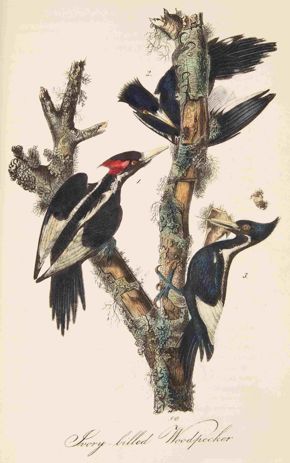
John James Audubon, Ivory-billed Woodpecker, from The Birds of America, 1840–44, hand-colored lithograph, promised gift of Steve and Shelli Lindley.
Edward P. Cogger and McLoughlin Bros., King Gobble’s Feast or the Fatal Effects of Pride, 1869, gift of Virginia Hamilton in memory of Sims McCutchan.
John Cassin and William E. Hitchcock, Kirtland’s Owl, from Illustrations of the Birds of California, Texas, Oregon, British and Russian America, 1862, gift of Marshall Lux.
July 12–October 28, 2023
Publishing in 19th-century America mirrored the nation’s ambitions as the country sought to fulfill its Manifest Destiny. Volumes depicting uncharted flora and fauna were among the genres that caught the public’s imagination and found a welcome market.
Colorplate books featuring birds yielded some of the most spectacular publications, with the octavo edition of The Birds of America by John James Audubon serving as the high-water mark. Audubon’s publication and similar illustrated books helped to expand awareness of birds to elite buyers of expensive volumes. More-modest publications reached a wide audience: middle-class readers, scientists, political leaders, and even children.
Birdwatching by the Book features 11 publications culled from the Hirsch Library and Powell Library that reveal American bird illustration at its apex. These books expanded awareness to a nation keen for a better understanding and appreciation of its avian neighbors.
► On-site
Hirsch Library is located on the lower level of the Audrey Jones Beck Building.
► Online
The virtual edition of Birdwatching by the Book is available 24/7.
► See the library catalog listing for the books and periodicals included in the exhibition.
Dan Walsh: Minimalist at Play
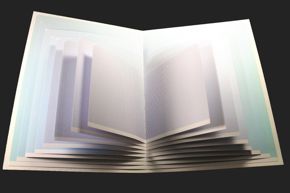
Dan Walsh: Minimalist at Play
Dan Walsh: Minimalist at Play
January 11–July 8, 2023
Over the past 25 years, New York–based artist Dan Walsh has incorporated book production into his artistic practice, receiving wide acclaim for his virtuosic and playful artist’s books. Walsh (born 1960) works within the minimalist tradition, which is often characterized as cold and austere. However, he brings a warmth to his productions by exposing his process and the variations created by the human hand. Subtle imperfections play out on the pages of his books in the form of irregularities of line, brushstroke, and coloration.
Ultimately, Walsh challenges himself and the viewer to remain present by focusing on minute details while remaining open to the broader possibilities within a highly controlled environment. The nine books on view in Minimalist at Play feature Walsh’s adept skills through a range of media including watercolor, acrylic, ink, and pencil, as well as technical processes such as woodcut printing, cut paper, and bookbinding.
► Visit on-site
Hirsch Library is located on the lower level of the Audrey Jones Beck Building.
► Online
The virtual edition of Dan Walsh: Minimalist at Play is available 24/7.
Best viewed on the latest versions of Chrome, Firefox, Microsoft Edge, and Safari.
► See the library catalog listing for the books and periodicals included in the exhibition.
(Un)making the Book: Artists and Repurposed Materials
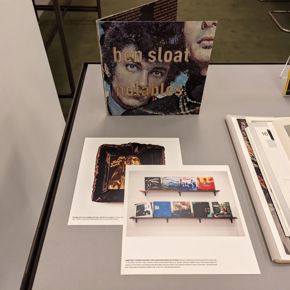
(Un)making the Book: Artists and Repurposed Materials
(Un)making the Book: Artists and Repurposed Materials
(Un)making the Book: Artists and Repurposed Materials
(Un)making the Book: Artists and Repurposed Materials
September 21, 2022–January 7, 2023
Nearly since the inception of books and manuscripts, artists and creators have treated written or printed materials as pliable and changeable objects and forms. Medieval marginal notes and experimentation gave way to processes such as erasure and collage, the main idea being that in the right hands printed matter is never a “finished” product, but rather a stepping stone toward further creation and experimentation.
Each of the artists in this exhibition has taken an existing book or set of print materials and fundamentally altered and changed it to suit particular purposes, at times creating entirely new narratives and visual language or destroying original meaning and function altogether to create conceptual art objects completely “unreadable” in the traditional sense. Published novels, hardware catalogues, and personal ads are all fair game to be absorbed, reconfigured, and metamorphosed into completely new expressions of artistic intention.
► Visit on-site
Hirsch Library is located on the lower level of the Audrey Jones Beck Building.
► See the library catalog listing for the books and periodicals included in the exhibition.
Not Playing Around: The Unconventional Use of the Card in Modern and Contemporary Art
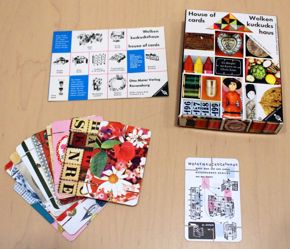
Not Playing Around: The Unconventional Use of the Card in Modern and Contemporary Art
Not Playing Around: The Unconventional Use of the Card in Modern and Contemporary Art
Not Playing Around: The Unconventional Use of the Card in Modern and Contemporary Art
November 3, 2021–March 12, 2022
Cards are a part of the human experience all over the world in myriad ways, including for pleasure, divination, and gambling. This exhibition explores how artists have used cards in modern and contemporary art over the past 70 years. The selections are divided into three categories: functional cards, tarot decks, and documentation. The functional examples include baseball cards, playing cards, postcards, and construction toys. The tarot decks feature imagery from art history, astrology, and contemporary photography. Representing documentation are exhibition catalogues and loose-card artists’ books.
The objects in Not Playing Around were created to be used and interacted with, which flips the usual dynamic between art and viewer. The juxtaposition of elements that typically would not be compared leads to new interpretations. Although each artist approached the format in a different way, the exhibition illustrates how cards can represent artistic intention outside traditional means and showcases the interconnections between artists across time and locations.
► On-site
Hirsch Library is located in the Caroline Wiess Law Building.
► Online
The virtual edition of Not Playing Around is available 24/7.
Best viewed on the latest versions of Chrome, Firefox, Microsoft Edge, and Safari.
Bookbinding Uncovered: Materials, Techniques, and Artistic Expression
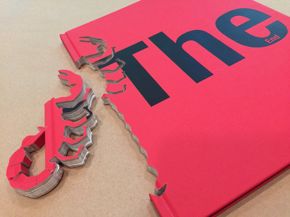
Robert The, The End: A Summing Up, New York: Peter Norton Family, 2018, the Museum of Fine Arts, Houston, Hirsch Library.
Jean Antoine Nollet, Leçons de Physique Expérimentale (Lessons in Experimental Physics), Paris: Laurent Durand, 1767–69, Sarah Campbell Blaffer Foundation.
Galileo Galilei, Galileo a Madama Cristina di Lorena (Galileo to Madame Christina of Lorraine), Padua: Salmon, 1896, originally published 1615, the McWhirter Miniature Book Collection, the Printing Museum.
Alexander von Humboldt, Cosmos: A Sketch of a Physical Description of the Universe, London: H. G. Bohn, 1849–1958, the Museum of Fine Arts, Houston, Hirsch Library.
Vincenzo Filicaia, Poesie Toscane, [Florence]: Presso Leonardo Ciardetti, 1827, courtesy of Jackie Mazow.
July 14–October 30, 2021
Spanning nearly 400 years, Bookbinding Uncovered explores the history of the book through the production process, techniques, and materials. Bookbinding materials illustrate the progression of technological advances, from the use of animal skins for producing vellum bindings to the application of synthetic fabrics made of PVC. Materials begin to tell a story about a book’s contents and provenance, as in Vocabulario y Refranero Criollo, featuring a cowhide binding with a branded title.
Many embellishments familiar today, such as marbled paper, gold, and striped headbands, are imitations of historical bookbinding techniques created by skilled artisans centuries ago. Identifying materials and techniques is essential to understanding not only the history of the book, but also tastes of a particular period or culture.
Fore-edge painting and miniature bindings are labor-intensive techniques that showcase technical achievement and serve a functional purpose, such as determining ownership or concealing information. Artists’ books with truly inspired bindings, such as those by Robert The and Dan Walsh, underscore that exceptional bookbinding also serves as an important medium for artistic expression.
► On-site
Hirsch Library is located in the Caroline Wiess Law Building.
► Online
The virtual edition of Bookbinding Uncovered is available 24/7.
Best viewed on the latest versions of Chrome, Firefox, Microsoft Edge, and Safari.
“Do Not Underestimate Our Power”: The Art World Activism of Howardena Pindell
March 24–July 10, 2021
Though Howardena Pindell started her artistic career in the 1960s making abstract paintings, over time she began incorporating bold social commentary in her work, illuminating the racist, colonial history of the United States. Pindell (born 1943) traced this history to the structures of white supremacy she observed. Not content to simply make art about ongoing oppression, she chose to take action. Pindell’s significance as an artist is matched by her enduring influence as an anti-racist organizer, writer, critic, and curator on New York’s cultural scene during the last decades of the 20th century.
Do Not Underestimate Our Power highlights Pindell’s vital contributions to a long-lasting dialogue and protest movement over racism in the art world. Books, periodicals, and archival materials from the 1970s to the 1990s illustrate milestones within this narrative and reveal the critical importance of collectivity and solidarity in the lives of artists of color. Beyond a history of art, this exhibition also offers a social and political history, in which Pindell and numerous collaborators define what it meant to be an artist intent on transforming society—laying the groundwork for a more-inclusive cultural field today.
► On-site
Hirsch Library is located in the Caroline Wiess Law Building.
► Online
The virtual edition of “Do Not Underestimate Our Power” is available 24/7.
Best viewed on the latest versions of Chrome, Firefox, Microsoft Edge, and Safari.
Making the Movable Book: An Evolution of Paper Engineering
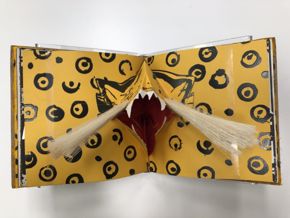
Ámbar Past, et al, Bolom Chon, 2008, first edition, Taller Leñateros.
Johann Remmelin and Lucas Kilian, Catoptrum Microcosmicum: Suis Aere Incisis Visionibus Splendens, Cum Historia & Pinace, De Nouo Prodit. Sumptibus Iohannis Görlini, Imprimebat Balthasar Kühne, 1639, the MFAH, Hirsch Library, Museum purchase funded by Cecily E. Horton.
Johann Remmelin and Lucas Kilian, Catoptrum Microcosmicum: Suis Aere Incisis Visionibus Splendens, Cum Historia & Pinace, De Nouo Prodit. Sumptibus Iohannis Görlini, Imprimebat Balthasar Kühne, 1639, the MFAH, Hirsch Library, Museum purchase funded by Cecily E. Horton.
Ralph H. Segal and Theodore I. Segal, Bodyscope, 1935, Bodyscope Publications, Inc., New York City.
Thomas Malton and Brook Taylor, A Compleat Treatise on Perspective, in Theory and Practice ..., 1779, second edition, corrected and improved, printed for the author, sold by Messrs. Robson, Becket, Taylor, Dilly, and the author.
Thomas Malton and Brook Taylor, A Compleat Treatise on Perspective, in Theory and Practice ..., 1779, second edition, corrected and improved, printed for the author, sold by Messrs. Robson, Becket, Taylor, Dilly, and the author.
December 2, 2020–March 20, 2021
Since the 13th century, bookmakers and artists have looked for ways to bring life to the structure and form of the traditional book. Techniques for achieving innovations include accordion folds, pop-ups, wheel charts (volvelles), flaps, pull tabs, pop-outs, and pull-downs.
Publications with these attributes became known as “movable books.” Although pop-up books and movable books are often associated with children, these texts were created as instructional tools for adults and were published as scholarly works. The subject matter encompassed anatomy, astronomy, cryptography, and more. Even though techniques have evolved, construction methods continue to link artists’ and bookmakers’ works from different periods across the globe.
Making the Movable Book: An Evolution of Paper Engineering investigates the multidimensional ways artists and publishers have played with techniques to expand the boundaries of the traditional book. The exhibition reflects the abiding fascination with such paper mechanisms through titles from the Hirsch Library’s collection.
► On-site
Hirsch Library is located in the Caroline Wiess Law Building.
► Online
The virtual edition of Making the Movable Book is available 24/7.
Best viewed on the latest versions of Chrome, Firefox, Microsoft Edge, and Safari.
Echoes of Harlem: The Graphic Work of Aaron Douglas
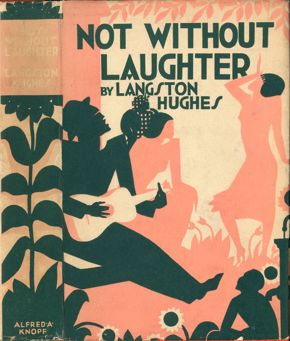
Langston Hughes, Not Without Laughter, illustrated by Aaron Douglas, New York: Alfred A. Knopf, 1930, the Museum of Fine Arts, Houston, Hirsch Library.
Carl Van Vechten, Aaron Douglas, 1933, gelatin silver print, Philadelphia Museum of Art, gift of John Mark Lutz, 1965.
Arthur Huff Fauset, For Freedom: A Biographical Story of the American Negro, illustrated by Aaron Douglas, Philadelphia: Franklin Publishing and Supply Co., 1927, the Museum of Fine Arts, Houston, Hirsch Library.
Claude McKay, Banjo: A Story without a Plot, illustrated by Aaron Douglas, New York: Harper and Brothers, 1929, the Museum of Fine Arts, Houston, Hirsch Library.
Charles S. Johnson, Opportunity: Journal of Negro Life, illustrated by Aaron Douglas, February 1926, New York City: Department of Research and Investigations, National Urban League, 1923–49, the Museum of Fine Arts, Houston, Hirsch Library, Museum purchase funded by Eugene Foney.
March 10–November 29, 2020
Aaron Douglas (1899–1979) was a graphic artist, painter, and teacher who began his artistic career during the period recognized today as the Harlem Renaissance. He came to Harlem in 1925, inspired by the writings of African American philosopher Alain Locke, who called for a New Negro renaissance in black art and literature that would contribute toward racial equality in America. Douglas’s work appeared in major publications, from black journals like The Crisis and Opportunity, to books published by Alfred A. Knopf and Harper & Brothers.
The covers and texts of noted Harlem Renaissance writers—including Langston Hughes, James Weldon Johnson, and Claude McKay—also featured Douglas’s illustrations. In his graphic work for these publications, Douglas developed a visual language inspired by African art, Art Deco design, and black vernacular music, such as jazz and the blues. Through this synthesis, Douglas created an unparalleled black artistic expression that was distinctly modern.
► On-site
Hirsch Library is located in the Caroline Wiess Law Building.
► Online
The virtual edition of Echoes of Harlem is available 24/7.
Best viewed on the latest versions of Chrome, Firefox, Microsoft Edge, and Safari.
► See the library catalog listing for the books and periodicals included in the exhibition. All of the publications are part of the Hirsch Library’s growing collection of materials related to the Harlem Renaissance.
Modernist Myths: Aesthetics of Identity in Latin American Graphics
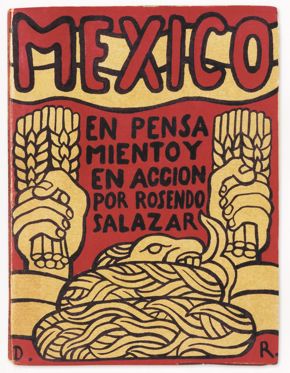
Rosendo Salazar and Diego Rivera, México en pensamiento y en acción (Mexico in Thought and Action), México City: Editorial Avante, 1926.
Francisco Rojas González and Fermín Revueltas Sánchez, El Pajareador (The Blaster), México City: Bosque, Impresor, no date.
Blaise Cendrars and Tarsila do Amaral, Feuilles de route, le Formose (Road Maps), Paris: Au Sans Pareil, 1924.
José Vasconcelos, El Maestro: revista de cultura nacional (The Master: National Cultural Magazine), v. 2, no. 4/5 (Jan/Feb 1922), México: La Universidad, 1921–23.
Nahui Olin and Dr. Atl, Energía Cósmíca (Cosmic Energy), México: Botas, 1932.
November 19, 2019–March 7, 2020
During the nationalist reconstruction of the 1920s, avant-garde Latin American artists and writers aimed to subvert European exceptionalism in their quest to explore a postcolonial, postrevolutionary identity. Understanding that European culture could not be ignored, artists realized that it could be used to their advantage. Imported printing techniques and the prevailing Modernist style were adapted to reframe indigenous visual culture and advance a revitalized American identity.
The circulation of local or indigenous mythologies and pre-Hispanic aesthetics in magazines and affordable paperbacks provoked a revolutionary spirit, disrupting power relations rather than reinforcing them. With a dedication to potent imagery, the materials in Modernist Myths illustrate the birth of an American Modernism that inverted, while often exploiting, international influences.
► See the library catalog listings for the books included in the exhibition.
The Revolution Will Be Publicized: Printing the Resistance
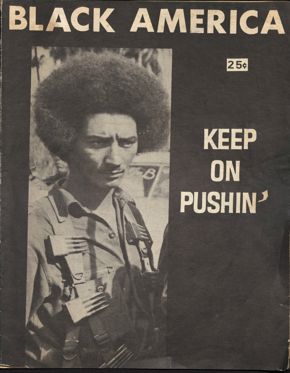
Black America, summer/fall 1965, New York, New York: Revolutionary Action Movement (RAM), Hirsch Library collections, the Museum of Fine Arts, Houston.
Heresies, v. 3, no.1, issue 9, 1980, New York, New York: Heresies Collective, Hirsch Library collections, the Museum of Fine Arts, Houston.
The Black Panther, Black Panther Community News Service, v. 3, no. 8, June 14, 1969, Oakland, California: Ministry of Information, Black Panther Party, 1967–80, Hirsch Library collections, the Museum of Fine Arts, Houston.
Carlos Stahl, Siembra, v. 3, no. 25, April 1945, México, D.F.: Confederación Nacional Campesina, Hirsch Library collections, the Museum of Fine Arts, Houston.
July 30–November 16, 2019
“The revolution will not be televised”—a slogan made popular by the 1960s Black Power movement in the United States—was later used as a song title and immortalized further by poet and musician Gil Scott-Heron. At its heart, the phrase suggests that traditional media outlets and sources of information, ensconced as they are in maintaining the status quo, are incapable of properly representing movements toward real social change.
The mid-20th century was a time of great social upheaval throughout the United States and the world. Faced with established outlets of information either incapable of, or unwilling to, represent their ideas, resistance movements turned to creating their own publications, periodicals, and newsletters to communicate their messages and unite their members.
The Revolution Will Be Publicized presents periodicals of resistance from the Hirsch Library’s special collections. The exhibition focuses on mid-20th century Mexican political and labor publications; newsletters and pamphlets from the Black Power and Civil Rights movements; and later antiwar, queer, and feminist periodicals from the 1960s and 1970s.
► See the library catalog listings for the books included in the exhibition.
Alluring Melancholy: Representations of the Tormented Artist
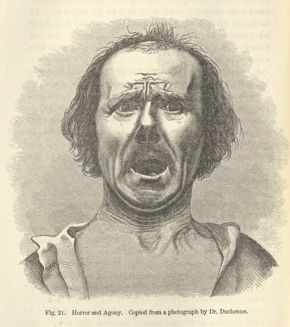
Charles Darwin, The Expression of the Emotions in Man and Animals, London: John Murray, 1872, the Museum of Fine Arts, Houston, Hirsch Library, the Manfred Heiting Book Collection, gift of Manfred Heiting.
Unica Zürn, Oracles et Spectacles: Quatorze Poèmes-Anagrammes et Huit Eaux-Fortes, Paris: Éditions Georges Visat, 1967, the Museum of Fine Arts, Houston, Hirsch Library, gift of Alvin S. Romansky.
Deborah Kass, Between the Lines: A Coloring Book of Drawings by Contemporary Artists, New York: RxArt, 2011, the Museum of Fine Arts, Houston, Hirsch Library.
April 9–July 27, 2019
The tormented artist, frequently embodied by Vincent van Gogh, is an easily recognizable archetype and often a real-life person. This character may be withdrawn from society and suffering psychological turmoil—the impetus for creating poignant works of art. Alluring Melancholy: Representations of the Tormented Artist explores the origins and development of this archetype through seminal art movements of the 18th, 19th, and 20th centuries, including Romanticism, Surrealism, Abstract Expressionism, and Art Brut.
Books from the collections of the Hirsch Library and the Sarah Campbell Blaffer Foundation illustrate how the philosophies of these movements have perpetuated the stereotype of the tortured artist. The exhibition also examines society’s preoccupation with the struggling artist, which in turn influences contemporary art and artists.
Alluring Melancholy focuses on Alice Neel, Jackson Pollock, Scofield Thayer, and Unica Zürn in the role of the tormented artist.
► See the library catalog listings for the books included in the exhibition.
Everyday Encounters: Erasing the Divide between Art and Life
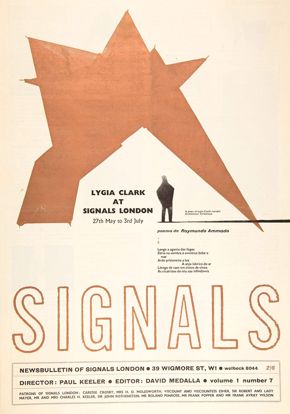
“Lygia Clark at Signals London: 27th May to 3rd July” in Signals: Newsbulletin of the Centre for the Advanced Creative Study (London, England), volume 1, no. 7 (April–May 1965), the Museum of Fine Arts, Houston, Hirsch Library.
Alison Knowles, Décollage: Bulletin of the Fluxus and Happening Avantgarde, no. 6, July 1967, Cologne: Vostell, 1962–69, the Museum of Fine Arts, Houston, Hirsch Library.
Yoko Ono, A Hole to See the Sky Through, 1971, the Museum of Fine Arts, Houston, Hirsch Library.
Edgardo Antonio Vigo, Hexagono ’71, La Plata, Argentina, 1971–75, the Museum of Fine Arts, Houston, Hirsch Library.
Edgardo Antonio Vigo, Hexagono ’71, La Plata, Argentina, 1971–75, the Museum of Fine Arts, Houston, Hirsch Library.
December 18, 2018–April 6, 2019
In the 1960s, breaking with a long tradition of art as object, avant-garde movements—such as Conceptualism and Fluxus—engaged with the chaos and absurdity of the times by dematerializing the art object. Everyday Encounters draws from the Hirsch Library’s collection of Conceptual and Fluxus books, periodicals, and ephemera to look at process-oriented artists through the lens of printed matter as interactive documents.
An essay by American writer and curator Lucy Lippard in 1968 predicted the complete disappearance of the traditional art object, and the increased power of ideas, concepts, and audience engagement. Working with everyday materials and invoking dynamic relationships between art and everyday life, artists began to illustrate this radical shift where encounters became the preferred medium, and ephemeral relics were often the only remnants.
Among the artists represented in Everyday Encounters: Erasing the Divide between Art and Life are Lygia Clark, Alison Knowles, Yoko Ono, and Edgardo Antonio Vigo.
► See the library catalog listings for the books included in the exhibition.
Creating “Collision: The Contemporary Art Scene in Houston, 1972–1985”
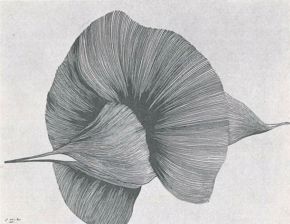
Invitation card for Dorothy Hood Drawings, 1975, Hirsch Library, the Museum of Fine Arts, Houston.
The B&E Holding Firm / David Gallery, Commemorative Document from “The Document Show,” 1971, ink on paper with foil seal, the Museum of Fine Arts, Houston, Hirsch Library.
August 28–December 15, 2018
The Hirsch Library and the MFAH Archives—the premier research facilities for scholars of Texas art—offer books, catalogs, and nearly 700 reels of microfilm produced by the Smithsonian Institution’s Archives of American Art. Also available are thousands of files containing ephemera related to artists and arts organizations from Houston and beyond. These files are particularly valuable, as they contain newsletters, résumés, gallery invitations, programs, and newspaper clippings of which few copies survive and which are sometimes the only existing record of obscure dates and events.
This exhibition presents highlights from the Hirsch Library’s collection that informed the research behind the new publication Collision: The Contemporary Art Scene in Houston, 1972–1985 (Texas A&M University Press) by Pete Gershon, program coordinator for the Core Program at the Glassell School of Art.
► See the library catalog listings for the books included in the exhibition.
Printing Pop: Andy Warhol On & Off the Page
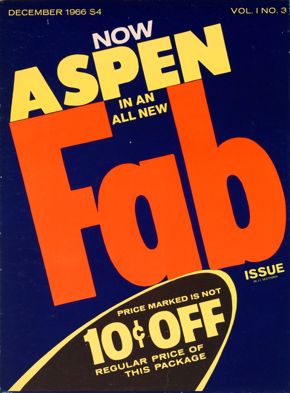
Andy Warhol and David Dalton, Aspen: The Magazine in a Box, Vol. 1, no. 3, 1966, the Museum of Fine Arts, Houston, Hirsch Library.
Andy Warhol and Alan Neame, The Adventures of Maud Noakes: An Autobiographical Account by the Authoress of the Noakes Report, 1961, the Museum of Fine Arts, Houston, Hirsch Library, gift of Randy Tibbets and Richard Bebermeyer.
Andy Warhol and David Antin, Some/thing, Vol. 2, no. 1 (Winter), 1966, the Museum of Fine Arts, Houston, Hirsch Library.
May 1–August 25, 2018
Andy Warhol (1928–1987) epitomizes the concept of the multitalented, mixed-media artist. During his career, the Pop artist embraced painting, printmaking, filmmaking, photography, and graphic design. Although sometimes overshadowed by his explorations of other media, books and magazines were central to his artistic production. He created nearly 100 books and more than 400 magazine commissions between 1948 and his death. For Warhol, these formats provided yet one more avenue to illustrate provocative juxtapositions of high and low art, the effects of serialization, relations between the visual and textual, and the blurring of authorship.
Featured publications from the Hirsch Library’s collection provide a view of Warhol’s playful and often thought-provoking engagement with printed matter. These materials highlight his various—and sometimes overlapping—roles as illustrator, author, designer, and publisher.
► See the library catalog listings for the books included in the exhibition.
Written with the Body
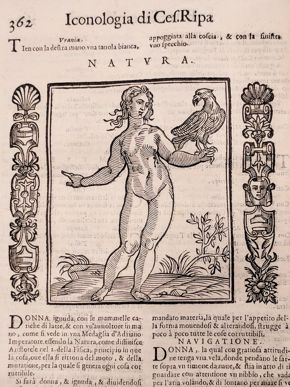
Cesare Ripa, Iconologia, Padova: Per P. P. Tozzi nella stampa del Pasquati, 1618, the Museum of Fine Arts, Houston, Hirsch Library, gift of Edgar Peters Bowron in memory of Anthony M. Clark.
Kara Walker, Freedom: A Fable, 1997, California, Peter Horton Family, the Museum of Fine Arts, Houston, Hirsch Library.
December 19, 2017–April 28, 2018
Written with the Body considers the female form in art history through housekeeping manuals, photobooks, artists’ books, and gallery catalogues from the Hirsch Library collection. Portrayed by prominent male artists over centuries, the female form has represented many different ideas and themes: idealized femininity; charged symbol of fertility; arrested object of desire.
Increasingly, however, women are reclaiming their form to promote new body images and meaning systems. This exhibition offers a look at female writers and artists documenting their own perspectives to reveal an engagement with the body not as a fixed site, but instead as a space where nuanced, personal associations emerge.
► See the library catalog listings for the books included in the exhibition.
Documenting a Transformative Gift: Books and Archival Materials from Edith A. and Percy S. Straus
August 29–December 16, 2017
In 1941, Edith A. and Percy S. Straus gifted the Museum of Fine Arts, Houston, with their distinguished collection of European Pre-Renaissance and Renaissance masterworks, forever transforming Houston’s prominence as a center for art.
Over the years, their generous bequest was complemented by a gift of 135 books and catalogues, as well as a rich trove of archival materials from the couple’s personal holdings. This exhibition—featuring key documents culled from the Hirsch Library and the Museum Archives—offers a better understanding of the figures who shaped the Straus Collection, and how they thoughtfully pursued each object.
► See the library catalog listings for the books included in the exhibition.
Reading Music: Sound Recordings and the Book
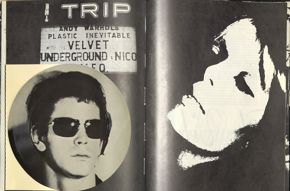
Andy Warhol, Andy Warhol’s Index (Book), 1967, New York: Random House, the Museum of Fine Arts, Houston, The Manfred Heiting Book Collection, Museum purchase funded by the Caroline Wiess Law Accessions Endowment Fund.
Revolutions per Minute (The Art Record), 1982, New York: Ronald Feldman Gallery, the Museum of Fine Arts, Houston.
April 25–August 26, 2017
From the mid-20th century to the present day, visual artists have worked to expand the perception of the book as a mere container for textual information, subverting expectations and toying with formal elements to make objects typically considered documents into interactive works of art. A similar tradition of experimentation and play exists in another medium: recorded sound. Reading Music presents a selection of books that incorporate sound recordings as well as artists’ original sound works from the Hirsch Library’s collection in an attempt to explore ways artists have used both the textual and aural to create hybrid spaces of expression.
► See the library catalog listings for the books included in the exhibition.
CLAP! 10x10 Contemporary Latin American Photobooks
March 2–April 8, 2017
“CLAP! 10x10 Contemporary Latin American Photobooks” features 130 contemporary Latin American photobooks published between 2000 and 2016. Organized by the nonprofit 10×10 Photobooks based in New York City, the project presents a hands-on opportunity to browse Latin American photobooks that are rarely seen in the United States.
The selected books represent many of the most exciting innovations in Latin American photography and publications today.
Drawn to Teach: Instruction Manuals from the 17th to the 19th Century
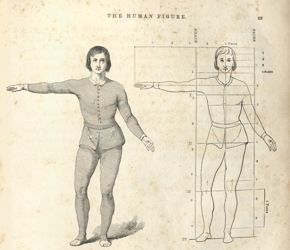
J.G. (John Gadsby) Chapman, illustrated figure showing the proportions of the human body from The American Drawing-Book: A Manual for the Amateur, and Basis of Study for the Professional Artist: Especially Adapted to the Use of Public and Private Schools, As Well As Home Instruction, 1847, New York: J.S. Redfield, the Museum of Fine Arts, Houston, Hirsch Library, gift of Emily Ballew Neff in Honor of Dr. and Mrs. Peter C. Marzio.
William J. Muckley, hand-colored example of leg muscles and bones from The Student’s Manual of Artistic Anatomy: Together with a Description of the Origin, Insertion, and Use of Muscles, 1885, London: Bailliere, Tindall, and Cox, the Museum of Fine Arts, Houston, Hirsch Library, gift of Edward Lukasek.
Thomas Bardwell, frontispiece of The Practice of Painting and Perspective Made Easy: In Which is Contained, the Art of Painting in Oil, with the Method of Colouring and a New Account of the Art of Perspective, 1756, London: printed by S. Richardson for the author, the Museum of Fine Arts, Houston, Hirsch Library, gift of Cornelia Long.
Thomas Bardwell, The Practice of Painting and Perspective Made Easy: In Which is Contained, the Art of Painting in Oil, with the Method of Colouring and a New Account of the Art of Perspective, 1756, London: printed by S. Richardson for the author, the Museum of Fine Arts, Houston, Hirsch Library, gift of Cornelia Long.
December 16, 2016–April 22, 2017
Since earliest recorded history, the basic human impulse to draw has been used to communicate ideas, express fears and desires, convey religious or political beliefs, and adorn the physical environment. From the Age of Enlightenment in Europe through the 19th century in America, drawing proficiency was considered not only a sign of refinement, but also an essential element in the repertoire of an educated person. With the aid of skillful teachers and written manuals, individuals of all ages could strive to master rudimentary perspective, nature and landscape, and human and animal figures.
Featuring works from the holdings of the Hirsch Library and the Sarah Campbell Blaffer Foundation, this exhibition explores the wide range of drawing manuals published in Europe and America from the 17th to the 19th century.
► See the library catalog listings for the books included in the exhibition.
Much Ado about Something: Shakespeare Illustrated on the Printed Page
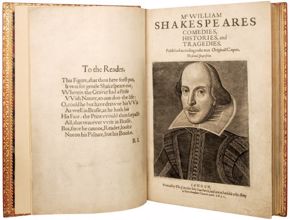
The Second Folio includes the only undisputed likeness of William Shakespeare: an iconic portrait by printmaker Martin Droeshout.
Printed by Thomas Cotes, for Robert Allot, London, Mr. William Shakespeares Comedies, Histories, and Tragedies, 1632, the Museum of Fine Arts, Houston, Masterson Book Collection, Rienzi.
John and Josiah Boydell, Boydell's Graphic Illustrations of the Dramatic Works of Shakspeare …, 1804, London: Messers. Boydell & Co., the Museum of Fine Arts, Houston, Hirsch Library.
New York: Museum of Modern Art, Jim Dine: Designs for A Midsummer Night's Dream, 1968, the Museum of Fine Arts, Houston, Hirsch Library, Lester Beall Collection.
London: Jones and Co., The Works of William Hogarth: In a Series of Engravings, 1833, the Museum of Fine Arts, Houston, Hirsch Library, gift of Richard Holley.
July 12–December 15, 2016
In 2016, we mark the 400th anniversary of the death of English playwright William Shakespeare. Although Shakespeare’s reputation is well established today, his legacy owes much to the visual arts over the past few centuries. It was largely through books, folios, and printed impressions that representations of his works were most widely seen and, in turn, his reputation enhanced.
This exhibition features nine publications—from the collections of the Hirsch Library and Rienzi—that highlight artistic responses to Shakespeare’s unique and lasting vision.
► See the library catalog listings for the books included in the exhibition.
Everything and Everyone: Artists’ Books Published by the National Museum of Women in the Arts
March 1–July 9, 2016
Artists’ books, which came to prominence as a medium in the mid-20th century, are best described as works of art that are conceived and executed by their makers as books. To make a book is to claim power over objects by giving physical embodiment to ideas.
Artists' books often take this concept a step further, as every aspect and creative choice behind an artist's book can be alive with meaning. To “read” an artist's book is to reckon not only with text, but also with structure and form.
The publications featured in this exhibition are selected largely from a gift of artists’ books published by the National Museum of Women in the Arts and given to the Hirsch Library by Renée and Stan Wallace in 2011. These works provide a cross-section of the many forms and creative possibilities of artists’ books.
► See the library catalog listings for the books included in the exhibition.
“Violence and Precision”: Artists’ Manifestoes
November 24, 2015–February 27, 2016
Originating in legal and political contexts during the Renaissance, manifestoes played a critical and defining role in many artistic movements of the 20th century as Futurists, Dadaists, and Surrealists embraced their power to challenge orthodoxy and fundamentally change visual practice. Through examples from the Hirsch Library's special collections, the exhibition Violence and Precision highlights a number of artists’ manifestoes from the early 20th century to the present.
► See the library catalog listings for the books included in the exhibition.
For information about past MFAH exhibitions, search the exhibitions archive database.
Meet the Books
Hirsch Library Exhibition Tours
To complement the library’s exhibitions, the Hirsch Library staff often schedules “Meet the Books” tours. These tours are free and open to the public. Learn more

